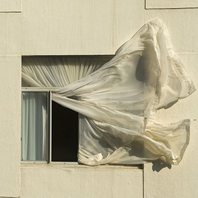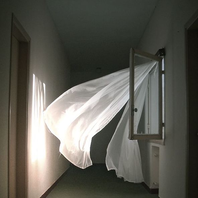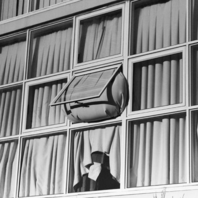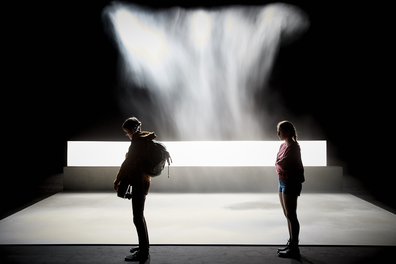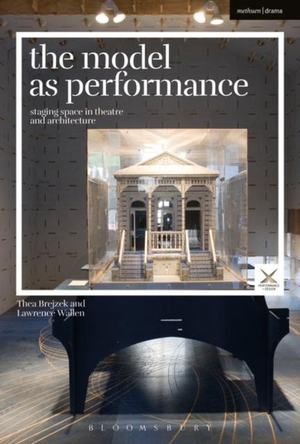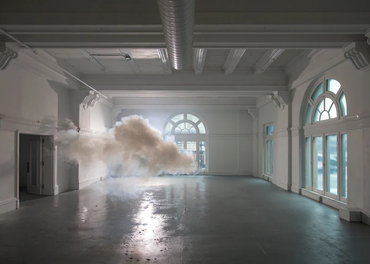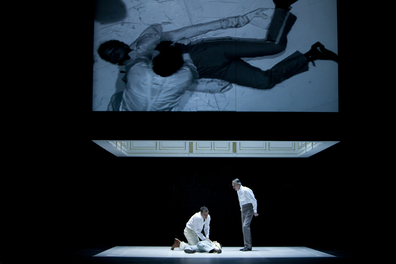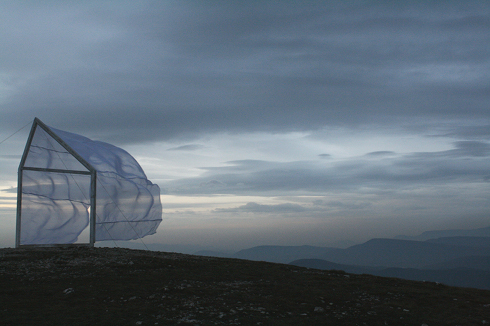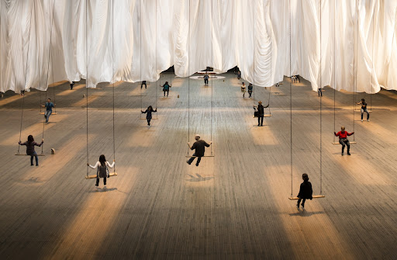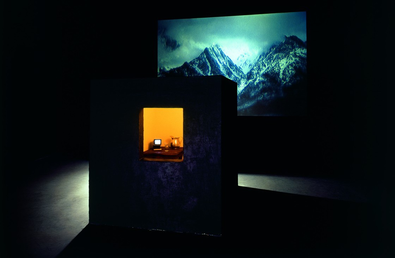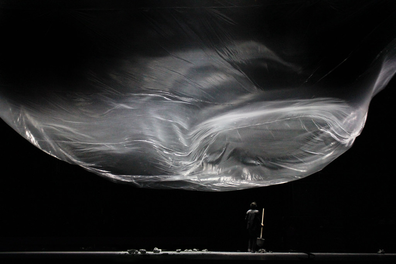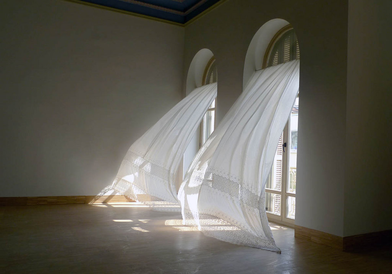To - in and from the window
(Share your Practice_november 2021).
Installation into a blackbox, divided into two parts:
1. At the beginning and with a sketch as means, the abstraction of one of the "wind situations" rpreviously recorded, generating a portal situation towards the meeting of the wind. In this way, the wind appears as a presence on the "other side of the door", making itself felt through the use of sound and light.
2. The second part was the ´encounter with wind´, an immersive experience walking touched by this ´windy materiality´on motion in a big scale, from where the spectator was exploring this tactility and motion on space, at the same time that it was streaming from the ´eye of wind´ , from the inside of this ´living surface´ surface.
Playing with the role of the spectator from his/her perpective and dimension, through the use of model to capture the focus in a small scale and then through immersive situations, to be bodily explored, making the spectator smaller and smaller in his/her confrontation with the wind.
The practice starts from the observation and recognition of a ´sensorial nostalgy´ to the original place, which has been activated from the remoteness through the presence of wind, identifying it as the most recognizable landscape’s element in Patagonia. From there, I began a research based on the collection of situations where this element became the activator of the space. An intangible performer, that turns visible, a presence through motion, giving to space the sense of time.
From these captures as content, I have started an exploration of the different wind’s scales or types, a dissection of its presence and how it seems and is perceived by others, in a range of dimensions as shape, speed, sound, temperature, light, weight ,among others. And as well some conditions that it needs, or that are required to make it appears.
Taking this material and the use of video as means, I am exploring methods to translate it to spatial situations ´windy atmospheres´. Where the wind becomes the performer, playing with the role of the spectator, using as methodology the scale, either in size; creating immersive experiences or building sketches, as abstraction pieces of certain situations. But also from the sensoriality in terms of its materiality and how the body perceives it, going deeper about the ´shape of the wind´ and how it is present.
From here, other questions began to appear as to what the wind supposes in its spatial presence and what not? what happens when the wind doesn't appear? or when the wind is expected? How is experienced this remembrance?
As scenographer, I identify the wind as the performer of my work, giving to it a dramaturgical role (being present or abssent) – a character, experimenting from its perspective the relationship between the spectator and the space, that I called ´the wind’s eye´, which coincidentally corresponds to the etymological origin of the word ´window´.
Eugenio Mimica, Tierra del Fuego, en días de viento ausente.
Tierra del Fuego, on days of absent wind.
(Editorial Cuarto Propio, 2004, pp. 14 - 16).
Fragment:
Leaving only a little dust suspended in the air in a confused manner, moments before falling into repose. The motorcycle seems a fantasy presence, meaningless in that place where shelter almost does not exist. Its driver, alone in such a vast solitude, has taken off his helmet, to awaken his awareness of his surroundings. He needs to have his head uncovered to feel the air. But even so, he does not manage to diminish the suffocation of his face.
He leaves the helmet between his legs, on the fuel tank. When he took it off, kilometers back, he realized that his hair was soaked with sweat and thick saline drops slid down his forehead and neck. He needed to take off his jacket as well, tying it on the back seat. He felt hot and it was at that moment that he realized how curiously calm the afternoon was. He had not noticed it previously when leaving town. Now he realized that it was an afternoon from other latitudes, from other realities, rare. An afternoon without atmosphere, ghostly, out of this world. Not even a shy breeze was present and the environment seemed to stop. That was the strange thing. It seemed to him as if the wind had gone forever, given up its condition of blowing for days, nights, weeks, months. And by moving away it had taken all movement, any semblance of life in that flat scenery where he was passing through.
But it was not the only sensation. The wind, so he thought with his heart skipping without knowing why, had no reference and could not be defined. It had stopped to be what it was, becoming a word without meaning, irremediably empty. Because without it, he meditated while he looked at that horizon, no one could imagine if it had a common or singular shape, if it was colorful or gray, if it was high or low, wide or thin. Nor could anyone know if it wears clothes or walks completely naked, if it is sweet or sour. Now, due to its sudden and unexpected absence, the wind was only a confused memory that perhaps had never existed. Maybe it was just imagination. So much was the calm of that afternoon, so much was the strangeness, the silence seemed absolute and artificial. He looked up and the blue of the clear sky, open as a portal to the eternity of the universe, blinded his eyes and made him feel small, insignificant under such magnitude.
He slowed down until he stopped the motorcycle. He put his feet on the ground, and noticed that the silence drowned even more that perception of escaped air. He thought he was the only living being around and felt again his restless heartbeat. He thought that perhaps the whole world had escaped along with the wind or that the wind had taken everyone but him, leaving him hopelessly alone.
Instinctively his arms turned the handlebars of the motocycle, hoping to turn back, to get back on the road. But he thought quickly that he could not run away from there just for loneliness. How could he say at home that he felt afraid of the spectral atmosphere, of the strange stillness and the absolute disappearance of the wind. He could not explain that.
Page 70.
Maybe, one has wholly to eliminate man on the stage...Will man be replaced by a shadow, reflex, a projection of symbolic forms, or by a being which seems to be alive without being alive? I don't know but the absence of man appears absolutely necessary to me. (Maeterlinck 1890:331).
Flökt (2020)
Bára Sigfúsdóttir
A bodily exploration with the world sorrounding us. It suggests that nature is also something we can sense and experience, an environment in a constant state of transition, allowing to feel proximity of things, bodies, space, sound, lights and massive presence.
The model as performance (2018)
Thea Brejzek
Model as an epistemic tool for the creation of a fictional reality and discourse. Empirical discover through models.
La Brèche (2019)
Tommy Milliot
Use of light as landscape, from its dynamics in tonality, speed, intensity, among others.
Nimbus (2020)
Berndnaut-Smilde
Work with a huge physical aspect, focused on a transitory moment of presence in a specific location. Interpretation of loss or becoming, before everythinf fall apart again.
Glut and decadence (2015)
Jan Versweyveld
Scales in a simultenous way, playing with the perspective of the spectator from the multiple gaze of the performance.
Wind's presence from home
Sequence of 6 simultenous recordings in diferent static frames of the presence of wind, from the same interior space.
Capturing its direction, sound, interaction between spaces, and overlap of images.
Basic House (2015)
Martín Azúa
Almost immaterial spaces, created from wind through the body. "Having it all (freedom) without having almost anything", as an alegory of this element. A reinterpretation of the idea of habitat in a more essential way.
Event of thread (2012)
Ann Hamilton
Large scale installation, combining the ephemeral presence of time with the tactility of the material. Multisensory affair, becoming a colective being from the individual experience.
Room for St. John of the Cross (1983)
Bill Viola
Use simultaneous of the model as sculpture and the background in projection, as reflection and representation of the contrast between the inside situation and the exterior.
Still life (2015)
Dimitris Papaioanno
Immersive environments, creating nature admospheres that involve the perfomer, starting a play with his/her scale in the set.
Room for St. John of the Cross (1983)
Adolphe Appia
Use simultaneous of the model as sculpture and the background in projection, as reflection and representation of the contrast between the inside situation and the exterior.
